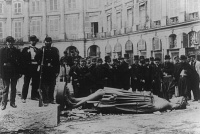Place Vendôme
From The Art and Popular Culture Encyclopedia
|
Related e |
|
Featured: |
Place Vendôme is a square in the 1st arrondissement of Paris, France, located to the north of the Tuileries Gardens and east of the Église de la Madeleine. It is the starting point of the Rue de la Paix. Its regular architecture by Jules Hardouin-Mansart and pedimented screens canted across the corners give the rectangular Place Vendôme the aspect of an octagon. The original Vendôme Column at the center of the square was erected by Napoleon I to commemorate the battle of Austerlitz; it was torn down on 16 May 1871, by decree of the Paris Commune, but subsequently re-erected and remains a prominent feature on the square today.
History
Place Vendôme was laid out in 1702 as a monument to the glory of the armies of Louis XIV, the Grand Monarque and called Place des Conquêtes, to be renamed Place Louis le Grand, when the conquests proved temporary; an over life-size equestrian statue of the king was set up in its centre, donated by the city authorities; this was by François Girardon (1699) and is supposed to have been the first large modern equestrian statue to be cast in a single piece. It was destroyed in the French Revolution; however, there is a small version in the Louvre. This led to the popular joke that while Henri IV dwelled among the people by the Pont Neuf, and Louis XIII among the aristocrats of the Place des Vosges, Louis XIV preferred the company of the tax farmers in the Place Vendôme; each reflecting the group they had favoured in life.
The site of the square was formerly the hôtel of César, duc de Vendôme, the illegitimate son of Henry IV and his mistress Gabrielle d'Estrées. Hardouin-Mansart bought the building and its gardens, with the idea of converting it into building lots as a profitable speculation. The plan did not materialize, and Louis XIV's minister of finance, Louvois, purchased the piece of ground, with the object of building a square, modelled on the successful Place des Vosges of the previous century. Louvois came into financial difficulties and nothing came of his project, either. After his death, the king purchased the plot and commissioned Hardouin-Mansart to design a housefront that the buyers of plots round the square would agree to adhere to. When the state finances ran low, the financier John Law took on the project, built himself a residence behind one of the façades, and the square was complete by 1720, just as his paper-money Mississippi bubble burst. Law suffered a major blow when he was forced to pay back taxes amounting to some tens of millions of dollars. With no way to pay such an amount, he was forced to sell the property he owned on the square. The buyers were members of the exiled Bourbon-Condé family who later returned to the country to reclaim their land in the town of Vendôme itself. Between 1720 and 1797, they acquired much of the square, including a freehold to parts of the site on which the Hôtel Ritz Paris now stands and in which they still maintain apartments. Their intention to restore a family palace on the site is dependent on the possible intentions of the adjacent Justice Ministry to expand its premises.
The Vendôme Column
Napoleon erected the original column, modelled after Trajan's Column, to celebrate the victory of Austerlitz; its veneer of 425 spiraling bas-relief bronze plates were made out of cannon taken from the combined armies of Europe, according to his propaganda (the usual figure given is hugely exaggerated: 133 cannon were actually captured at Austerlitz). These plates were designed by the sculptor Pierre-Nolasque Bergeret and executed by a team of sculptors including Jean-Joseph Foucou, Louis-Simon Boizot, François Joseph Bosio, Lorenzo Bartolini, Claude Ramey, François Rude, Corbet, Clodion and Henri-Joseph Ruxthiel. A statue of Napoleon, bare-headed, crowned with laurels and holding a sword in his right hand and a globe surmounted with a statue of Victory (as in Napoleon as Mars the Peacemaker) in his left hand, was placed atop the column


